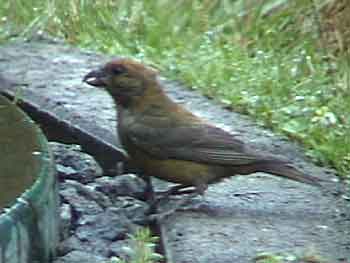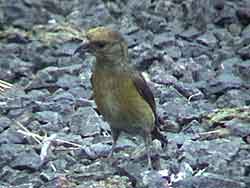Red Crossbill
Red Crossbill Video Clips

These erratic and nomadic finches, uncommon in our area, are attracted to the bird bath - especially the drippers. Besides arriving for the Hemlock harvest, we also see small groups of them pecking in rocky areas looking for insects, buds and seeds.
Crossbill Types
Biologists say there are as many as nine species each with a different call. Each species recognizes their own kind and they do not cross-breed. There is a species that specializes eating hemlock seeds, another that eats lodgepole seeds, and another that eats only ponderosa pine seeds. Each species has a specially adapted bill for opening the cones of their own key tree species. Large-billed species prefer pines while the small-billed species prefer spruces.
Irruption vs Superflight
Red Crossbills rely primarily on conifer seeds as their food source. As with most trees, conifers are unreliable in seed production. When the cone supply fails, the crossbills are forced to flock outside their normal range searching for food. When this happens, it is called an "irruption."
Red- and White-Crossbills, Evening Grosbeaks, Pine Grosbeaks, Purple Finches, Pine Siskins, Common Redpolls and Hoary Redpolls are considered "winter finches." Superflight, a rare event, occurs when several species of these "winter finches" wonder outside their normal winter range.
How Crossbills Get Crossed Bills
According to researchers, it is when the fledglings are learning to extract conifer seeds for themselves that the tips of both top and bottom bills begin growing. When the bird begins to pry the top bill sideways, it always twists the bill in the same direction. The upper mandible always curves down and the lower mandible always curves up.
Because the White-winged Crossbills remove the cones from trees, they can manipulate them and are not limited by their bills to pry open the cone scales in only a right or left position. Thus, White-winged Crossbills are three times more likely to have their bills crossed right rather than left. However, Red Crossbills are just as likely to have their bills crossed right as left. Because Red Crossbills leave cones on the branches, they cannot always position themselves in the correct spot to be able to pry open all the scales leaving half of the scales untouched. This allows the crossbills with the opposite crossing bills to eat the untouched cone scales.

Crossbills Nesting All Year
Because their favorite foods are more abundant during the winter, they often begin nesting in January. There are a number of references to the fact that Red Crossbills nest every month of the year and construct two nests. Winter nests consist of twigs, wood fibers and lichens while the summer nest is constructed using soft vegetable matter, feathers and down.
